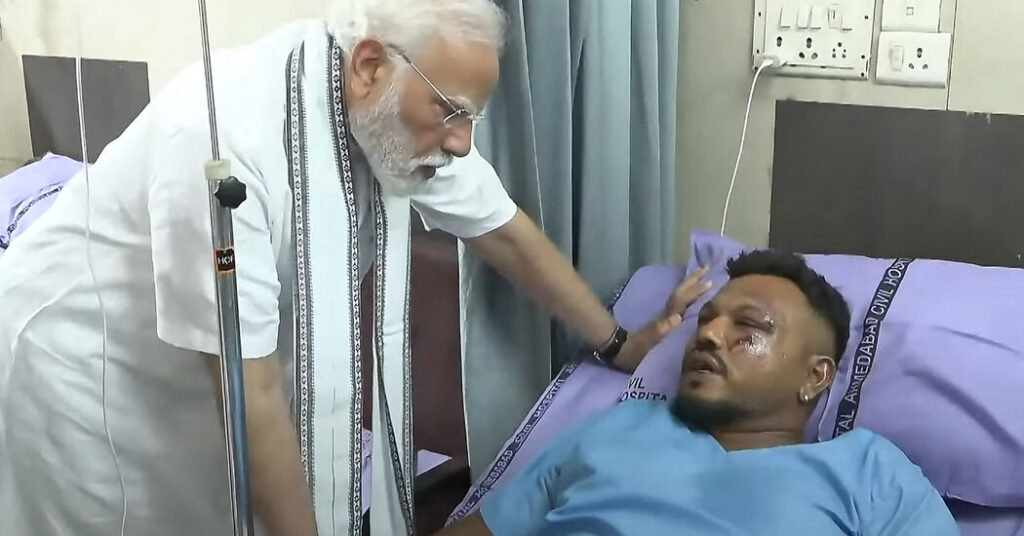On a fateful Thursday, June 12, 2025, Air India Flight 171, a Boeing 787-8 Dreamliner, took off from Sardar Vallabhbhai Patel International Airport in Ahmedabad. A technical failure led the aircraft to crash mere moments later, resulting in devastating loss of life as it plummeted into a crowded area. Out of 242 individuals onboard, only one survivor emerged from the wreckage: Viswash Kumar Ramesh. His miraculous survival became a beacon of hope amidst the darkness of a tragedy that shook an entire community.
The Crash: A Chronology of Events
The incident occurred shortly after takeoff when the aircraft aimed to ascend but instead faltered dramatically. Reports indicated that the plane managed to reach an altitude of about 625 feet before it began its perilous descent. Just moments later, it crashed into a crowded canteen at the BJ Medical College, located less than two kilometers from the airport.
The canteen, filled with students and staff during lunch hour, transformed into a nightmarish scene as the airplane tore through it. Eyewitness accounts describe chaos as a deafening roar filled the air before an explosive impact sent debris flying. Moments prior, laughter and chatter echoed in the canteen—a stark contrast to the panic that ensued.
“We thought it was lightning at first. The sound was unlike anything we had heard,” remembered a local doctor.
– Witness account
As flames engulfed the scene, emergency responders rushed in while local residents bravely worked to rescue those trapped beneath the rubble. Amidst the flames and panic, Ramesh emerged as a survivor, albeit with profound injuries—a testament to the chaos that unfolded on that tragic day.
Viswash Kumar Ramesh: The Lone Survivor
Ramesh, a 38-year-old businessman, found himself in Seat 11A as the aircraft turned into a fireball mid-air. In the immediate aftermath of the crash, grainy footage of Ramesh, bloodied but walking, circulated widely on social media, shocking a nation. His presence alone heralded the miracle of survival as he narrated his escape from the inferno.
In the days that followed, amid hospital visits and medical treatments, Ramesh’s story began to capture the attention of the media and the public alike. India’s Home Minister, Amit Shah, paid a visit to Ramesh, further highlighting the poignant narrative of resilience amid horror. Observers expressed disbelief over Ramesh’s miraculous survival while others mourned the tragic loss of life.
The Community’s Reaction: Heightened Fears
The devastating crash not only claimed lives but also instilled an omnipresent fear among local residents living near airports. In the aftermath, a palpable sense of anxiety reverberated through communities, particularly those situated close to busy runways. Many voiced concerns about their safety and the feasibility of continuing to live in such high-risk environments.
In Ahmedabad, where the crash occurred, nearby residents reported sleepless nights filled with horror over what could easily befall them. Some recounted experiences of past incidents and suggested a collective fear of another tragedy haunting their homes and families. Memories of a crash in Patna in July 2000, when an Alliance Air plane crashed into Gizadi Bagh, resonated deeply, igniting long-buried fears.
“We have been living here for over 70 years; but now we are scared for our lives. Where do we go?” – Resident near Ahmedabad Airport
The deep-rooted fear was echoed across several regions, from Mumbai to Jaipur, as communities began to question their safety while the aircraft flew above. In areas where slums and densely populated neighborhoods were situated near airports, many residents grew increasingly restless. Reports emerged detailing their willingness to relocate if provided a safer alternative—signaling the gravity of their concerns.
Conclusion: A Call for Change
As the nation grapples with the aftermath of the Air India Flight 171 tragedy, the stories of valor and loss serve as poignant reminders of the perils associated with aviation. The miraculous survival of Viswash Kumar Ramesh stands as a testament not just to individual resilience but also to the spirit of the community that rallies around those affected by untold disasters.
Ultimately, this incident must be a catalyst for necessary changes within aviation safety practices, community planning near airport zones, and a deeper commitment to support those affected. The shared outcry for reform resonates harmoniously with collective hopes for a future where such tragedies remain mere outlines in history rather than Kafkaesque realities of ongoing life.

